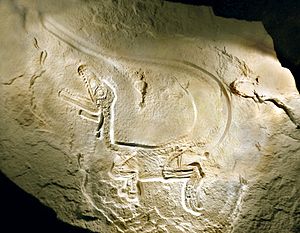Sciurumimus
| Sciurumimus | ||||||||||
|---|---|---|---|---|---|---|---|---|---|---|

Dissected holotype of Sciurumimus albersdoerferi |
||||||||||
| Temporal occurrence | ||||||||||
| Upper Jurassic (Upper Kimmeridgian ) | ||||||||||
| 154.7 to 152.1 million years | ||||||||||
| Locations | ||||||||||
| Systematics | ||||||||||
|
||||||||||
| Scientific name | ||||||||||
| Sciurumimus | ||||||||||
| Rauhut et al. , 2012 | ||||||||||
| Art | ||||||||||
|
Sciurumimus is a genus of theropod dinosaur from the Upper Jurassic . With Sciurumimus albersdoerferi , thegenus includesa single known species , which was first described in2012 on the basis of an almost completely preserved fossil skeleton of a young animalthat was found in the Bavarian community of Painten . When fully grown, Sciurumimus possibly reached a body length of several meters, was feathered at least as a young animal and, as a typical theropod, moved on two legs. Sciurumimus is a basic representative of the Megalosauridae .
features
The only known specimen of Sciurumimus is a juvenile individual about 72 cm long and a skull about 8 cm long. It is probably a newly hatched young animal; adult animals are likely to have reached far greater dimensions. Allosaurus juveniles, for example, were significantly shorter at 42 cm in a comparable development stage and reached a length of over 7 m when fully grown. Old animals of Sciurumimus are likely to have had a body length of 5 m and more, as long as there was no island dwarfing in this genus .

The head is relatively large compared to the rest of the body and has very wide nostrils. The foremost four teeth of the upper jaw are not notched, the remaining 33–35 upper teeth are clearly jagged on the back and point strongly backwards. This clearly distinguishes them from the usual dentition of the Tetanurae . One possible explanation for this is that at a certain stage of development there was a change of teeth in which the teeth were replaced with teeth that were serrated on both sides. Young animals probably ate different food than adults. The large head with the comparatively large eyes shows a childlike scheme . Sciurumimus has relatively short and strong front legs. They have three long toe links and claws that together make up around 45% of the leg length. The hind legs, on the other hand, are elongated as with all theropods (about 11 cm without feet) and enable the animals to move quickly in bipedal fashion. The tail is long and consists of a total of 59 vertebrae .
Around the fossil skeleton there are fine prints and remains of a feather down that apparently covered the animal's entire body. It consists of simple, around 0.2 mm thick, hair-like feathers and is particularly pronounced on the tail. Long and dense filament structures give it a fur-like surface and a bushy appearance.
Site and fossil material
The holotype of Sciurumimus ( BMMS BK 11) was found in 2009 or 2010 during excavations in the Rygol lime works near Painten in southern Germany . The Kelheim limestone layer belongs to the Beckeri zone of the Kimmeridgium , a chronostratigraphic stage of the Upper Jurassic . The fossil is about 151 million years old and one of the best preserved dinosaur fossils in the world. The geologist and fossil dealers Raimund Albersdörfer had financed the excavations, his wife Birgit, who owns the fossil, reported it as a cultural asset , and left it to the Solnhofener Mayor-Mueller Museum as a permanent loan .
Taxonomy and systematics
|
|||||||||||||||||||||||||||||||||||||||
| Relationships of Sciurumimus according to Rauhut et al. (2012) |
Sciurumimus albersdoerferi was 2012 by Oliver Rauhut , Christian Foth , Helmut table Linger and Mark A. Norell as a new species in a monotypic genus described . The researchers chose the generic name based on the bushy tail of the animal, which is reminiscent of that of squirrels ( Sciurus ) ( mimus "imitator"). The specific epithet honors the financier of the research, Raimund Albersdörfer.
On the basis of its skeletal characteristics, Sciurumimus was classified as a very original representative of the Megalosauroidea . He faces the rest of the group's representatives as a sister taxon . The fact that the proto-feathers of the genus do not differ in shape from the fluff found in some pelvic dinosaurs such as Psittacosaurus suggests that feathers do not develop in theropods. Rather, they may have been an original feature of all dinosaurs and may have been present in pterosaurs as well . So this feature would be a synapomorphy (common derived feature) of the Ornithodira .
Sources and References
literature
- Oliver WM Rauhut , Christian Foth, Helmut Tischlinger, Mark A. Norell : Exceptionally preserved juvenile megalosauroid theropod dinosaur with filamentous integument from the Late Jurassic of Germany. In: Proceedings of the National Academy of Sciences . Vol. 109, No. 29, 2012, pp 11746-11751. Doi : 10.1073 / pnas.1203238109 .
Web links
- www.br-online.de ( Memento from October 13, 2011 in the Internet Archive )
- Spiegel online from October 12, 2011: Complete dinosaur skeleton discovered for the first time in Europe
- Down-soft dinosaur found - website of the Ludwig Maximilians University in Munich
Individual evidence
- ↑ Rauhut et al .: Exceptionally preserved juvenile megalosauroid theropod dinosaur. 2012, pp. 11746-11748.
- ↑ Rauhut et al .: Exceptionally preserved juvenile megalosauroid theropod dinosaur. 2012, pp. 11748-11749.
- ↑ Rauhut et al .: Exceptionally preserved juvenile megalosauroid theropod dinosaur. 2012, p. 11751.
- ↑ Rauhut et al .: Exceptionally preserved juvenile megalosauroid theropod dinosaur. 2012, p. 11746.
- ↑ Rauhut et al .: Exceptionally preserved juvenile megalosauroid theropod dinosaur. 2012, pp. 11750-11751.